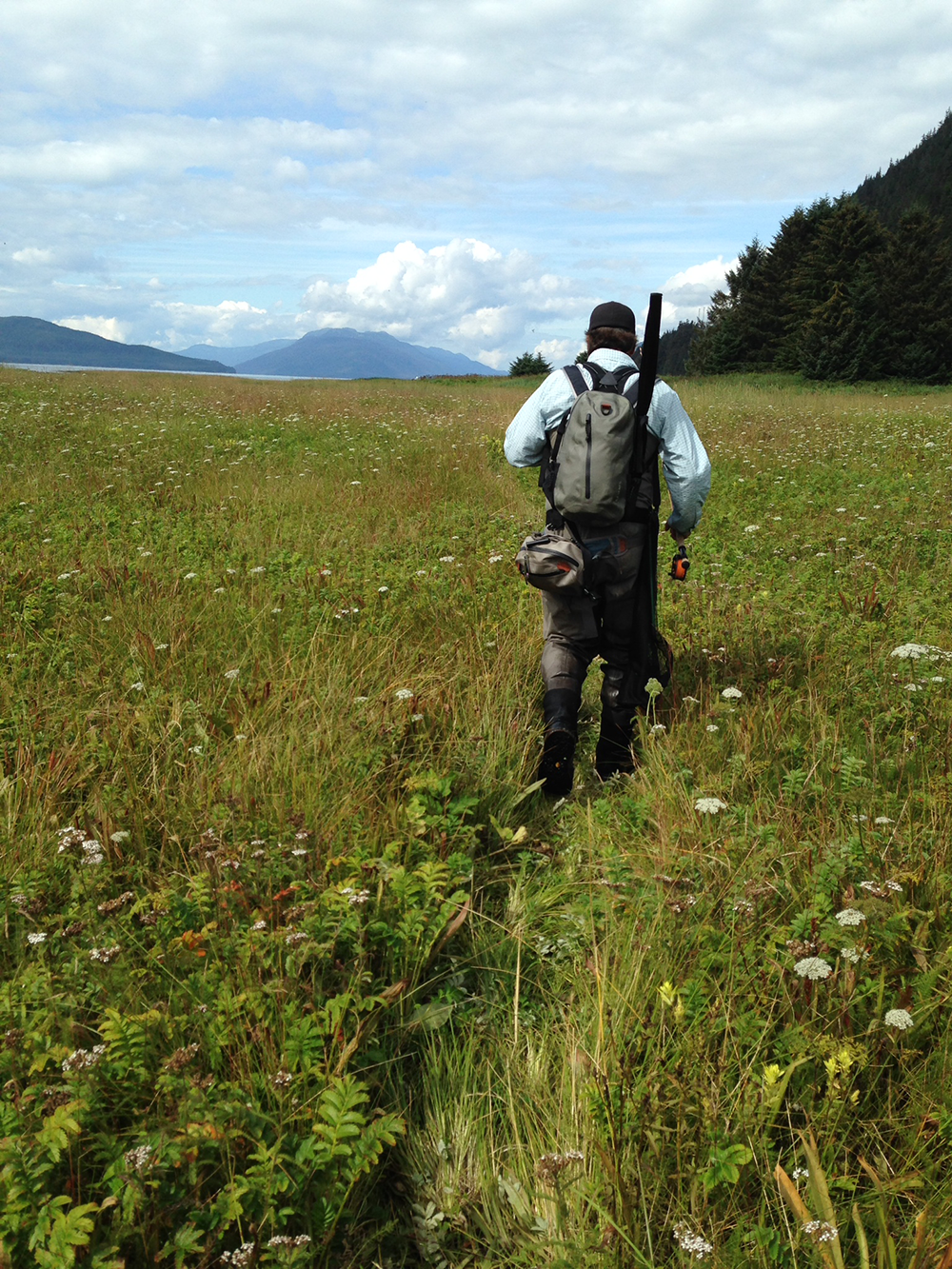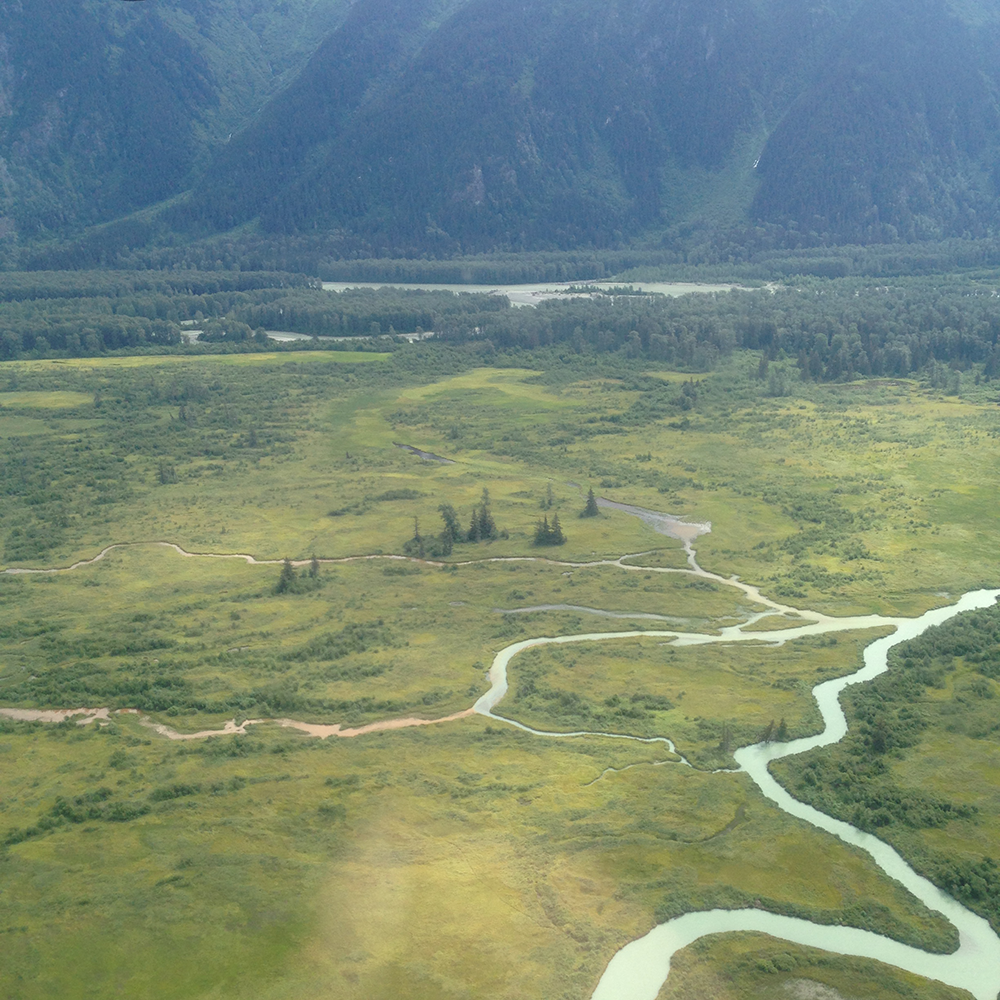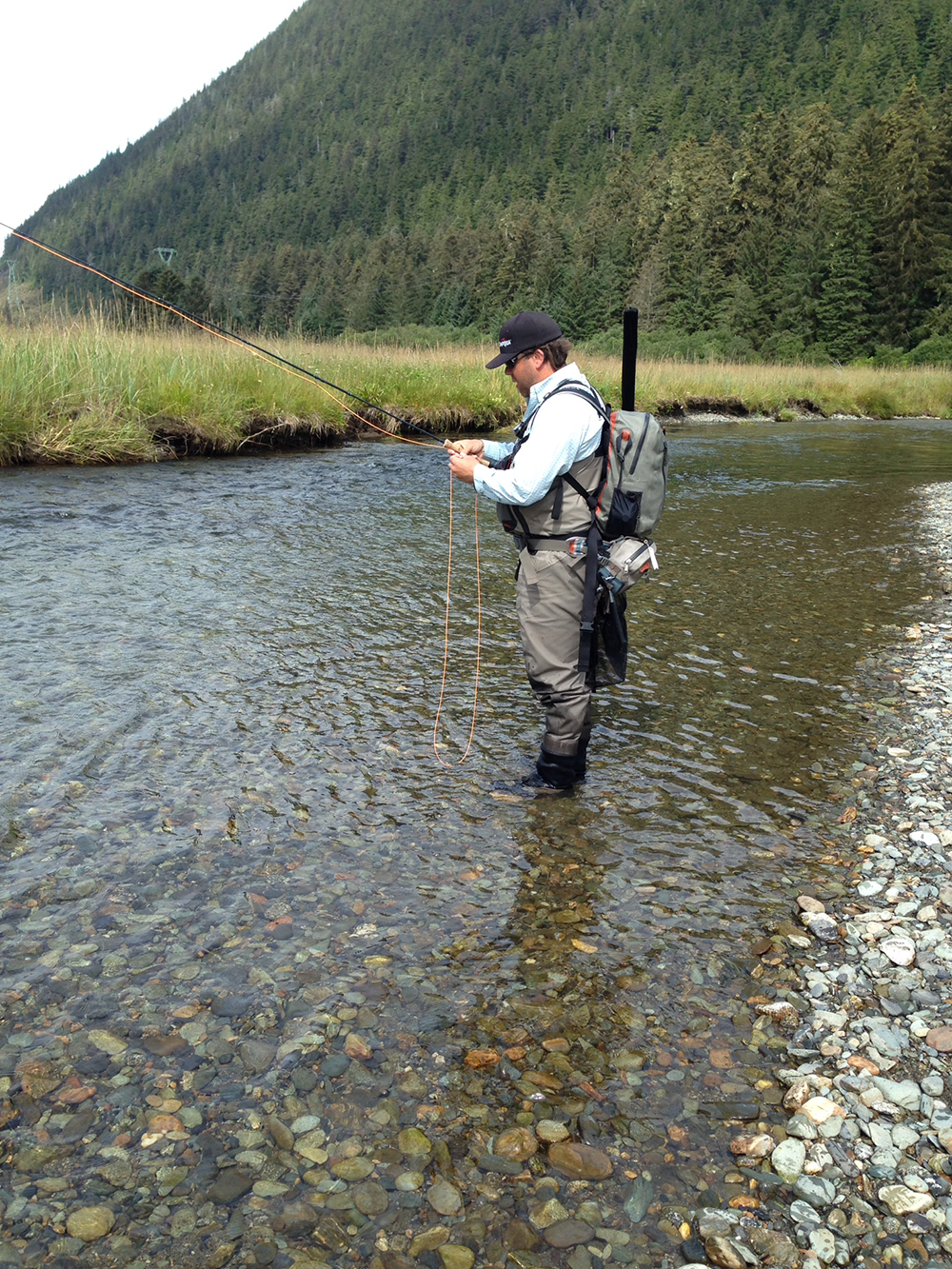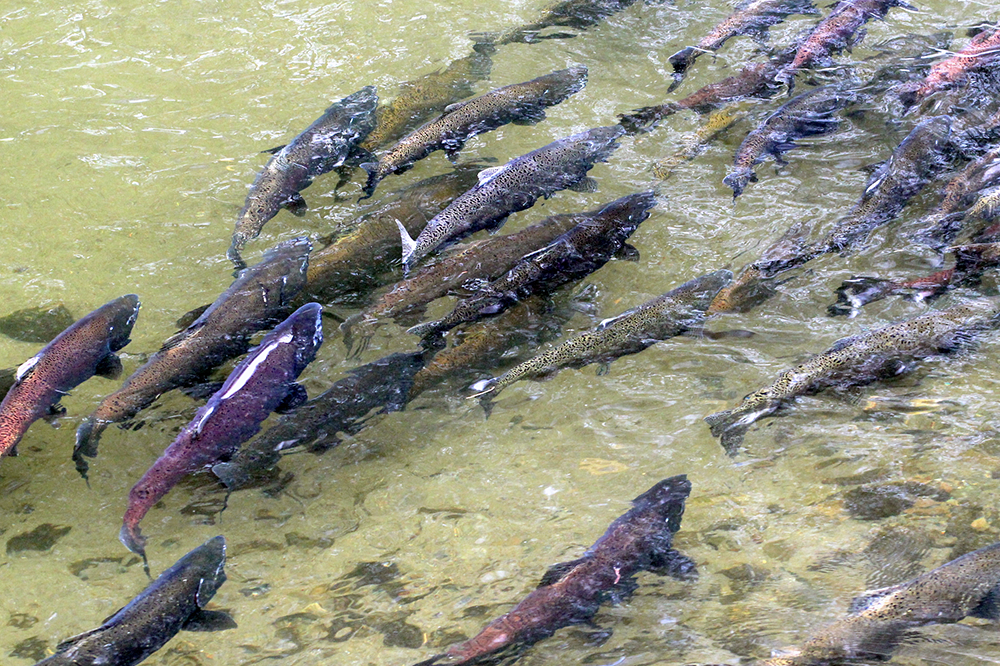Alaskan River Riches: Fly-fishing and Salmon Science
Air Date: Week of January 16, 2015

Mark Hieronymus fishes in a stream just outside of Juneau. (Photo: Emmett FitzGerald)
Living on Earth’s three-part series, Alaskan River Riches, looks at Southeast Alaska’s salmon economy and potential threats from mining. In the first segment, reporter Emmett FitzGerald wades through a small stream near Juneau for a lesson in casting and salmon science from a fly-fisherman with a conservation ethic.
Transcript
CURWOOD: It's Living on Earth. I'm Steve Curwood. Summer in Southeast Alaska is salmon season. As the days grow long, the iconic fish begin to run up rivers and streams, and the fishing economy jumps to life. Juneau isn’t the biggest fishing town in the region, but salmon are everywhere: on every restaurant menu, on t-shirts in gift shops, and in the harbor hundreds fishing boats constantly come and go. Just a few miles outside of the city small commercial fishing boats cruise around the mouth of the great Taku River, netting the salmon as they head upstream. Juneau is also a popular jumping-off point for fly-fishing trips, and sport fishing is an important source of income. Living on Earth’s Emmett FitzGerald spent some time in Juneau in the summer of 2014, reporting on the fish, their importance to the people who live there, and potential threats to the salmon that drive the local economy. And a fly-fisherman with a conservation ethic gave Emmett a lesson in casting and salmon science.
FITZGERALD: It’s a blue summer day, about as warm as it gets in Southeast Alaska. Fly-fishing guide Mark Hieronymus has the morning off, but he’s more than happy to spend it at one of his favorite fishing holes—although he’s not about to let me give away the precise spot on national radio.
HIERONYMUS: You could say that we’re at a small stream very close to the mouth of Taku River in Taku inlet.
[SOUND OF TRAMPING ALONG BANKS]
FITZGERALD: In chest high waders, we tramp along the pebbled banks. Where the stream narrows, Mark wades in and we slosh across to the other side.
[SOUND OF SLOSHING WATER]
FITZGERALD: The rushing water squeezes the waders tight and cold against my legs, and I have to lean into the current to avoid toppling over.
[SOUND OF SLOSHING WATER CONTINUES]
FITZGERALD: On the other shore Mark sets up shop. He puts his pole together, ties on a feathery orange fly, and starts showing me how it’s done.
HIERONYMUS: You’re going to go like this with this rod, you’re gonna cast it back out there and you want to cast this kind of gentle, so I’ll show you this cast called a roll cast.
FITZGERALD: K.
HIERONYMUS: If it ever tightens up that’s a fish.
FITZGERALD: There’s so many fish in this stream that even I manage to get a few bites, but Mark’s the real master here. As the line dances back and forth above his head, he tells me about the different salmon in Southeast Alaska.
HIERONYMUS: The largest of those in terms of numbers are pink salmon. The run sizes fluctuate but this year, to give you an idea, this is going to be a poor run of pink salmon this year and they’re projecting a harvest of around 22 million with a total escapement of somewhere over 30 million.
FITZGERALD: There’s five salmon species in all. As well as the pink there’s Chum, Coho, Sockeye…

Hiking in, fishing pole in hand. (Photo: Emmett FitzGerald)
HIERONYMUS: And then we get King Salmon too, that run in here. Those are the commercially caught fish and then we have also steelhead, which is the anadromous form, the ocean going form, of rainbow trout. That’s sort of the prized sportfish, that’s the crown jewel of most sport catches and here in Southeast Alaska we have officially about 330 streams with steelhead in them. But if you talk to folks that have fished for them for a long time they’ll tell you that that number is closer to 450 streams of steelhead in ‘em.
FITZGERALD: This one?
HIERONYMUS: This one does have Steelhead but you don’t have to print that.
FITZGERALD: Mark lands his fly a few feet from the opposite bank, just above a cluster of dark shadows hanging in the water. They look like rocks to me, but Mark says they’re pink salmon, or as he calls them, humpies after the characteristic hump on back of the male. These humpies are in their final days of life, waiting for more salmon to join them upstream. When they get a quorum, they’ll spawn and die.
HIERONYMUS: These humpies have a two-year life cycle. So these fish here when they spawn, they’ll die and they enrich the stream here. And the young swim out to sea next year, next spring. Those fish will return in 2016 in the same numbers, sometimes even more.
FITZGERALD: It doesn’t take long for Mark’s fly to get some action.
HIERONYMUS: Well, this is a pink salmon. Looks like a female, and it’s a little one -- grabbed it.
[SOUNDS OF FLOPPING AND SPLASHING]
FITZGERALD: There you go.
HIERONYMUS: Yeah. It’s got a little nip on the outside of him there. There’s seals that sit out off of this, the river mouth here and the seals’ll try to grab the fish.
FITZGERALD: Wow, look at that thing. So you think that wound there is a seal?
HIERONYMUS: Yeah that’s most likely a seal; it’s pretty fresh.
FITZGERALD: Is that going to be life-threatening to that fish?
HIERONYMUS: Well, the thing about it is this fish is on its spawning run, so its days are numbered right now, and so that wound might get infected, but that’s not going to be the cause of it dying. The cause of it dying is going to be—it’s on its spawning run; it was gonna die anyway.

A tributary in the Taku River Valley, a major salmon river that flows into the sea outside of Juneau. (Photo: Emmett FitzGerald)
FITZGERALD: The salmon life cycle is a well-documented natural wonder. Somehow, each fish manages to find its way back from the open ocean to a little stream like this one, where it was born. Scientists think they use the earth’s magnetic field and their sense of smell to help them get back home, but it’s still a bit of a mystery.
This summer, though, the salmon cycle was disrupted on one of the biggest sockeye rivers in North America. On August 12th, a dam holding back waste water from the Mt. Polley copper and gold mine in British Columbia burst, sending over 6 billion gallons of polluted water and mine waste into the Fraser River, just as the sockeye had begun to swim upstream. Mark says that as he watched the horrific images on the news, all he could think about was the salmon.
HIERONYMUS: Once they enter fresh water on their spawning run, their time is limited. And so they have to find clean gravel and have clean water to spawn in. That’s the whole reason these fish come back. So if there’s no place for them to do it or if the habitat is compromised, then the results are, potentially, you’re missing an entire year class of fish.
FITZGERALD: Canadian officials say the Fraser River Sockeye have weathered that spill fairly well, but it’s way too early to know what the long-term impact on the population will be. The wastewater was filled with heavy metals that could linger in the rivers and lakes for years to come, and that’s bad news for the salmon.
HIERONYMUS: What people don’t think about is the effects of some of these harmful toxins to phytoplankton or in-stream invertebrates. And if you lose that food base, then you’re going to lose the fish. It’s not an “if.” If there’s nothing there for them to live on, then you lose the fish. You’re basically ripping out the bottom of the food chain and the fish follow.
FITZGERALD: Mark hopes that the Mount Polley disaster is a wake-up call about the dangers of mining in sensitive watersheds. British Columbia is in the middle of a mining boom, and several BC mines are planned along rivers that flow right into Southeast Alaska—rivers like the Unuk, the Stikine, and the Taku, near where we are right now. Mark says if anyone doesn’t understand why these projects are a bad idea, just look at Mount Polley.
HIERONYMUS: The potential for something like that to happen, as we’ve seen, has now gone up greatly, because it has happened. And so to have it happen in a place that produces, place like, say, the Taku valley, or the Stikine valley, or the Unuk valley, that produces a substantial amount of Southeast Alaska’s fish, frankly it’s fairly horrifying.
FITZGERALD: As he talks, Mark is constantly casting, his arm rocking back and forth with a practiced finesse. He lays the line down on the water and lets the fly drift through the salmon shadows. If they don’t bite in five seconds, he yanks it out and starts again. For Mark, protecting fish is a personal economic issue. He’s had a lot of different jobs since moving to Juneau 25 years ago—seafood processor, fly designer, and today, as well as being a fly-fishing guide, he’s the Sportfish Outreach Coordinator for Trout Unlimited Alaska.

Mark is a fly-fishing guide based in Juneau. He takes tourists out on day-trips to streams like this one. (Photo: Emmett FitzGerald)
HIERONYMUS: People, when they find out I work for Trout Unlimited, they say, is that some kind of environmentalist organization? I say, no, we’re conservationists, there’s a big difference. I want to conserve it, so I can keep killing it and keep making money off of it. But they have to be around for me to do that.
FITZGERALD: Before long, Mark’s got another fish on the line.
[SOUNDS OF SPLASHING WATER]
FITZGERALD: He pulls the salmon out of the water. It’s another female, he says.
HIERONYMUS: The thing that people don’t really realize is that, if we give these guys fresh water – clean water – and a good habitat to spawn in, the management is such that these fish come back year after year after year and we can keep making money on them.
FITZGERALD: Mark pulls the hook out of the lip and slides the fish back in the water. It lingers for a moment then swims off. In only a few weeks, he says, she’ll lay her eggs and die. But if the water stays clean and the habitat healthy, he’ll be back on this bank in two years, trying to catch her children.
For Living on Earth, this is Emmett FitzGerald in Juneau, Alaska.
CURWOOD: Emmett FitzGerald is back now from Alaska and joins me in the studio. So Emmett, this sounds like quite the trip.
FITZGERALD: Yeah, Southeast Alaska is really a pretty remarkable place. It feels cliché to talk about how wild Alaska is, but really that's what it felt like to me coming from Boston—it's just this epic landscape, and you're right in the middle of it. You know, I was struck, I flew into Juneau and the first thing I realized pretty quickly is that there's no roads coming in and out of Juneau – it's the capital city of the biggest state in the union – there's no roads coming in and out it. But there's a ferry system, a public ferry system that connects all the different towns in Southeast Alaska, so when I left Juneau I took a ferry. I left at like 4 o’clock in the afternoon, and took a ferry overnight to this little town called Wrangle, far in the south of southeast Alaska. And I took the public ferryboat, and you're on this boat and you feel like you're on a cruise ship. You should have paid a luxury tour price to see the views that you're seeing, but you're really just traveling like everybody else. I expected there to be tourists on the boat, and there were some tourists, but it was mostly just everyday Alaskans going to see their family or they had business down south. And I was particularly struck, there was a high school sports on mine that was traveling to wherever their next game was.
CURWOOD: All the while you're going past this amazing scenery, these huge trees...
FITZGERALD: Yes, it’s the inside passage is this archipelago of islands, and I saw all kinds of wildlife. Right as the sun began to set, humpback whales started breaching all around the boat and it was pretty spectacular.
CURWOOD: How did you feel about the eagles that you'd see?
FITZGERALD: Yeah, for me, the first time I saw an eagle I pushed the guy next to me and said, “Oh my God, look it’s a Bald Eagle!” And the guy looked at me like, “Dude, whatever, it's a Bald Eagle. They’re everywhere.” And yeah, they’re like pigeons in Juneau; I must have seen thousands of Bald Eagles before I left.
CURWOOD: Now, tell us a bit about the mine that the fisherman in your story is so concerned about. I've heard about the Pebble Mine in Alaska, but these are different, right?
FITZGERALD: Yeah, I mean, Pebble is obviously a story that's got international attention over the last few years. That's this massive copper and gold mine in Bristol Bay, which is one of the biggest Sockeye producing fisheries in the world. And that project is kind of in limbo at this point. A lot of the major investors have pulled out, and now that EPA is involved it's in the court process. But as that has dragged on, some of these mining companies that aren't getting as much attention in British Columbia have really started to move forward. They're also still in a preliminary stage and some of them have big financial and regulatory hurdles to clear, but people in southeast Alaska – which is also a really important salmon fishery – are beginning to look at these mines and say, “Wait a second.” Because a lot of them are on riversheds that flow over the border from British Columbia into Southeast Alaska, and a lot of those fishermen depend on those riversheds.

King Salmon gather together to spawn. (Photo: Bigstockphoto)
CURWOOD: And, I gather when I heard in your piece about the Mount Polley disaster, that that's got people really concerned.
FITZGERALD: Yeah, the Mount Polley thing is really something that really highlighted the danger there for a lot of people. This video – you should take a look at it, we're going to have a link to it on our website – but the video is so startling—this torrent of gushing sludge from the Mount Polley mine pouring down this scenic river valley. And I think a lot of people saw that and were just really pretty terrified that something with some of these new mines could happen. It's obviously not, you don't know that just because a mine is built doesn't mean something disastrous like that is going to happen, but it definitely is a worst-case scenario and a lot of people are scared.
CURWOOD: So this week you took us fishing. Where are you going to take us next week, Emmett?
FITZGERALD: Yeah, so next week we're going to look at this mine which is near the Taku River, which is just outside of Juneau and a major salmon river, and it's called the Tulsequah Chief. The original Tulsequah Chief was abandoned over 50 years ago. It's a copper and gold mine, and there's still actually some pollution from that mine that's leaking into the river. But now, a new company is trying to redevelop the project. So what I'm going to do, I took a plane ride in this tiny little float plane and they're like, propeller planes and they're everywhere in Alaska because there's no roads. And so I went up there with a fisherwoman from Juneau and you get to hear her reaction when she sees this mine site and this potential mine perched right on the river that's so important to her business.
CURWOOD: I'm looking forward to it, Emmett. Thanks a lot.
FITZGERALD: Thank you.
Links
Read more about fly-fisherman and conservationist Mark Hieronymus
Living on Earth wants to hear from you!
Living on Earth
62 Calef Highway, Suite 212
Lee, NH 03861
Telephone: 617-287-4121
E-mail: comments@loe.org
Newsletter [Click here]
Donate to Living on Earth!
Living on Earth is an independent media program and relies entirely on contributions from listeners and institutions supporting public service. Please donate now to preserve an independent environmental voice.
NewsletterLiving on Earth offers a weekly delivery of the show's rundown to your mailbox. Sign up for our newsletter today!
 Sailors For The Sea: Be the change you want to sea.
Sailors For The Sea: Be the change you want to sea.
 The Grantham Foundation for the Protection of the Environment: Committed to protecting and improving the health of the global environment.
The Grantham Foundation for the Protection of the Environment: Committed to protecting and improving the health of the global environment.
 Contribute to Living on Earth and receive, as our gift to you, an archival print of one of Mark Seth Lender's extraordinary wildlife photographs. Follow the link to see Mark's current collection of photographs.
Contribute to Living on Earth and receive, as our gift to you, an archival print of one of Mark Seth Lender's extraordinary wildlife photographs. Follow the link to see Mark's current collection of photographs.
 Buy a signed copy of Mark Seth Lender's book Smeagull the Seagull & support Living on Earth
Buy a signed copy of Mark Seth Lender's book Smeagull the Seagull & support Living on Earth

